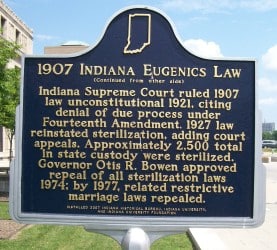When the weather throws you a curve, you have to adjust. That’s what happened recently as my wife and I took to the road for some kayaking in southern Indiana. No sooner did we arrive in Worthington than a slowly gathering bank of clouds to the north evolved into a deep blue wall. Steering into the city park, I pulled up the radar and confirmed we had a real mess heading our way. That was the bad news. The good news is that I had been meaning for years to stop at the park because of the legend of a massive sycamore that once grew near the town.
With just a few minutes to spare before turning south to outrun the storm, I jumped out of our truck and strolled over to the mammoth limb section preserved from the 500-year-old tree when it finally died. It truly is a sight to see. And it reminds me of how our state is dotted by little historical signs just waiting for someone to stop, someone to remember.
South of Crawfordsville you can stop where Chief Cornstalk’s Village once stood. Near Scottsburg you can visit the site of the Pigeon Roost massacre, all but forgotten in history books. In Corydon you can stand where Indiana’s only Civil War skirmish was fought. Just south of Indy you can stop and toss a quarter onto the grave of General George Washington’s drummer boy. In Bruceville you can stand where Lincoln spoke. History is everywhere, but in the age of smartphones and instant everything, all of these places are slowly fading into obscurity.
Such is the case for a little-known sign in one of the most highly trafficked areas of downtown Indy. Standing in silent witness between the Statehouse and a government building is a state historical marker shamefully recognizing a 1907 Indiana law legalizing eugenics through forced sterilization, a law ruled unconstitutional in 1921. It’s right there, a stone’s throw from the Statehouse, and yet I’ve only met one legislator who knows it is there. What is doubly-remarkable is that Justice Clarence Thomas recently referenced Indiana’s 1907 law in his blistering denunciation of eugenics in relation to Indiana’s protections for unborn children found in the 2016 Dignity for the Unborn Act.
Indiana’s 1907 eugenics program is a chapter of history we’d all like to forget, which is exactly why it is all the more important that we remember. History moves in circles, and what was once eugenics through forced sterilization in Indiana is now eugenics by targeting kids for abortion solely because of their race, national origin, sex, potential disability, or Down syndrome. God help us. And may God hasten the day when, next to the 1907 eugenics marker, a new one will be placed in sad remembrance of all of the children whose lives were taken during the Indiana eugenics program that began on January 22, 1973.


Recent Comments